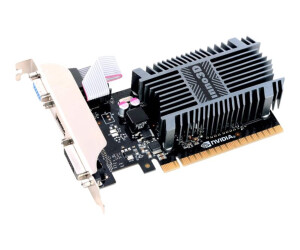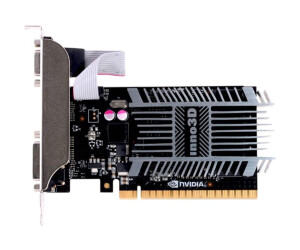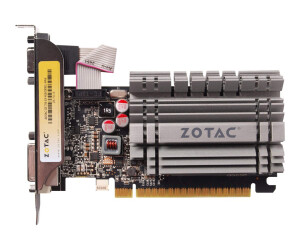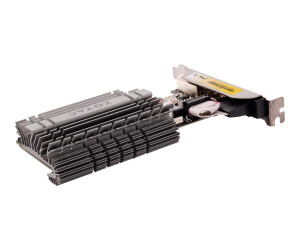Die NVIDIA GeForce GT is a family of graphics chipsets developed by NVIDIA. This series of graphics cards is primarily targeted towards mainstream and entry-level gamers, as well as users who require improved graphics performance for everyday tasks and multimedia applications. The GeForce GT chipsets offer a balanced combination of performance, energy efficiency, and cost-effectiveness.
The GeForce GT chipset is based on the NVIDIA Turing architecture, which provides a significant performance boost compared to previous generations. The Turing architecture is renowned for its advanced ray tracing features, enabling real-time realistic lighting effects and shadows. This greatly enhances the visual quality of games and applications.
The GeForce GT family includes various models such as the GT 1030, GT 1030 DDR4, GT 1030 GDDR5, GT 730, GT 720, and more. These models differ in terms of their technical specifications, such as core count, clock speeds, memory size, and memory type. For example, the GT 1030 series is more powerful than the GT 730 series and offers better support for modern games and applications.
The GeForce GT graphics cards feature dedicated graphics memory (VRAM), which allows for fast processing of graphics data. The amount of VRAM varies depending on the model, with options ranging from 2GB to 4GB. A larger VRAM enables the graphics card to handle larger and more complex texture and graphic data, resulting in improved performance.
NVIDIA equips the GeForce GT chipsets with various technologies that optimize graphics performance and gaming experience. These include features like NVIDIA Ansel, which allows users to capture high-resolution screenshots and 360-degree images of games, and NVIDIA G-SYNC, which reduces screen tearing and ensures a smooth gaming experience.
The GeForce GT graphics cards also support NVIDIA CUDA technology, which enables developers to utilize the graphics processors for general-purpose computing. This opens up possibilities for accelerating applications such as video encoding, image editing, and scientific simulations.
In terms of connectivity options, the GeForce GT graphics cards offer various interfaces, including HDMI, DisplayPort, and DVI. This allows for connection to different types of displays, such as monitors, televisions, and projectors.
Regarding energy efficiency, the GeForce GT graphics cards are designed to provide a good balance between performance and power consumption. They feature advanced power-saving features that dynamically adjust performance and reduce power consumption when less graphics performance is required. This allows the GeForce GT graphics cards to efficiently handle energy and minimize power consumption when they are not fully utilized. As a result, both operating costs are reduced, and heat generation is decreased, leading to cooler and quieter operation. These advanced power-saving features also contribute to extending battery life when the graphics card is used in a laptop or other mobile device. Overall, the advanced power-saving features of the GeForce GT graphics cards ensure that performance is available when needed while optimizing energy efficiency.
The NVIDIA GeForce GT chipset family offers solid performance for mainstream gamers and users who require improved graphics performance in everyday applications and multimedia experiences. With its advanced Turing architecture, dedicated VRAM, support for technologies like ray tracing, NVIDIA Ansel, and G-SYNC, as well as the ability to accelerate general-purpose computing through CUDA, the GeForce GT series provides a versatile and cost-effective solution.
While the GeForce GT graphics cards are not designed for high-end gaming or demanding professional applications, they meet the requirements of many users seeking reliable graphics performance. They are well-suited for games with moderate to low graphics demands and provide smooth playback of HD videos and multimedia content.
In conclusion, the NVIDIA GeForce GT chipset family is an excellent choice for those seeking a cost-effective graphics solution with solid performance and energy efficiency. With its balanced combination of features, technologies, and affordable price, the GeForce GT series offers a good option for the average user looking to take their graphics experience to the next level.
Advantages of the NVIDIA GeForce GT chipset family:
- Good graphics performance: The GeForce GT graphics cards provide solid graphics performance, allowing users to enjoy games and multimedia content in high quality.
- Versatility: The graphics cards are available in various performance levels, offering a wide range of options to meet individual requirements and budgets.
- Support for NVIDIA technologies: The GeForce GT graphics cards support NVIDIA technologies like CUDA and PhysX, leading to improved performance in certain applications.
- Connectivity versatility: With various ports such as HDMI, DisplayPort, and DVI, the graphics cards offer high flexibility in connecting to different monitors and displays.
Disadvantages of the NVIDIA GeForce GT chipset family:
- Limited performance for high-end gaming: Compared to the more powerful graphics cards of the NVIDIA GeForce GTX series, the GeForce GT models offer lower performance for demanding gaming applications.
- Limited memory and bandwidth options: Some GeForce GT models may have limited memory and bandwidth options, which can affect performance in certain scenarios.
- Limited overclocking capabilities: Compared to higher-end GeForce series, the GeForce GT models may offer fewer opportunities for overclocking the graphics card to further boost performance.
Despite these limitations, NVIDIA GeForce GT graphics cards provide solid performance and a good user experience for users seeking a reliable and cost-effective graphics solution.
In summary, the NVIDIA GeForce GT chipset family is a solid option for mainstream gamers and users looking for an affordable graphics solution. With its advanced Turing architecture, dedicated VRAM, and support for technologies like ray tracing, NVIDIA Ansel, and G-SYNC, the GeForce GT series offers a balanced combination of performance, features, and energy efficiency.
While the GeForce GT graphics cards were not designed for high-end applications or demanding gaming, they meet the requirements of many users who need improved graphics performance for gaming, multimedia content, and everyday tasks. Their advanced power-saving features allow efficient energy usage, contributing to cost savings.
While other NVIDIA graphics card series like the GeForce RTX are suitable for higher performance demands, the GeForce GT series provides an affordable option that still offers solid performance and modern features. For the average user who doesn't rely on peak performance, GeForce GT graphics cards are a good choice for playing games, watching HD videos, and performing general graphics-intensive tasks.
Ultimately, the choice of the right graphics card depends on individual requirements and budget. The NVIDIA GeForce GT chipset family offers a reliable, cost-effective solution for users seeking improved graphics performance without breaking the bank.












